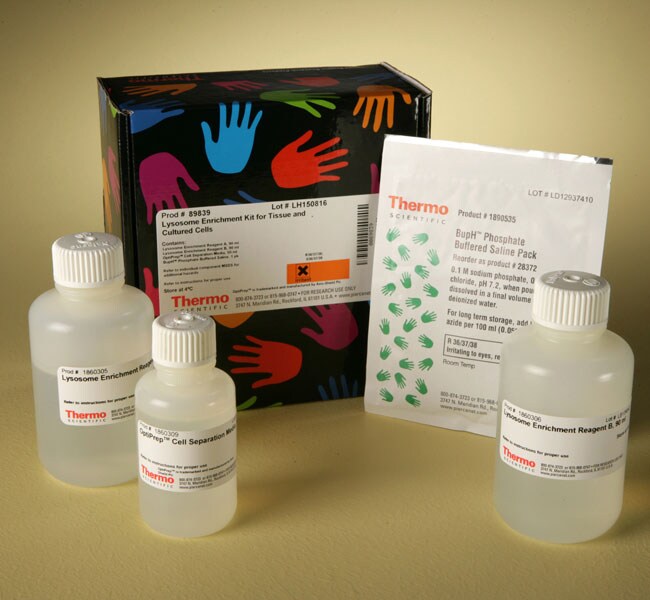
The Thermo Scientific™ Lysosome Enrichment Kit for Tissue and Cultured Cells enables isolation and enrichment for intact lysosomes from crude cell and tissue extracts. The kit provides sufficient reagents for preparing 25 extracts and uses OptiPrep Cell Separation Media for the density-based separation of lysosomes from contaminating cell structures. The isolated lysosomes may be used for a number of downstream applications, including 2D/MS for proteomics research, electron microscopy, disease profiling and gene expression, signal transduction, and interaction or localization.
Features of the Lysosome Enrichment Kit for Tissue and Cultured Cells:
• Efficient and easy to use—kit reagents and gradient centrifugation separate organelles from contaminating structures
• Compatible—prepare samples for downstream applications, including 2D/MS, electron microscopy, disease profiling, gene expression, signal transduction and interaction or localization studies
• Complete—kits contain sufficient material for 25 applications
This kit enables enrichment of intact organelles from cells and tissue. Each kit uses density gradient centrifugation to separate organelles from contaminating cellular structures. The isolated organelles may be used for a number of downstream applications, including 2D/MS, electron microscopy, disease profiling, gene expression, signal transduction and interaction or localization studies.
Organelle enrichment from tissue:
Six- to eight-week-old female Sprague-Dawley rats with an average weight of 160 g were fasted overnight before sacrifice. The liver and kidneys were excised, washed with ice-cold PBS, minced using surgical scissors and then homogenized in ice-cold Reagent A using a Polytron™ Tissue Tearer for 45 seconds at 8000 rpm. Reagent B was subsequently added and the homogenate was centrifuged to remove cellular debris. The resulting supernatant was overlayed on a discontinuous gradient of OptiPrep™ Cell Separation Media and centrifuged to isolate and enrich the targeted organelle. The target band was removed from the gradient and analyzed by Western blotting.
Organelle enrichment from cells:
Several cell lines were examined for lysosome isolation: A431 [American Type Culture Collection (ATCC™ Resource Center), #CRL-1555], HeLa (ATCC, #CCL-2), and HepG2 cells (ATCC, #HB-8065). The cells were grown to 80-90% confluency. Approximately 50-200 mg of wet cell paste was harvested and processed for lysosome enrichment. Ice-cold Lysosome Reagent A was added to the cells and lysis was performed using a Misonix Sonicator 3000 with 15 pulses delivering 15W of power.
Subsequently, Lysosome Reagent B was added, and the homogenate was centrifuged to remove cellular debris. The resulting supernatant was overlayed on several discontinuous gradients of the OptiPrep Cell Separation Media and centrifuged to isolate and enrich for the target organelle. The target band was removed from the gradient and, along with total lysate, normalized by protein amount (unless otherwise noted) and analyzed by Western blotting.
Related Products
Mitochondria Isolation Kit for Cultured Cells
Mitochondria Isolation Kit for Tissue
| Code | Description |
|---|---|
| 89839 | Catalog Number: 89839 |

